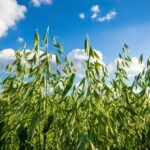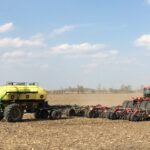An update from the field: June 2021 edition

Board Chair of Grain Farmers of Ontario, Brendan Byrne talks about what happened in May, what people can expect in June and predicts what July could look like in grain fields across Ontario.
Interview conducted by Caitlin Kroetsch, Communication Coordinator Co-op with Grain Farmers of Ontario, who is in her fourth year of Food and Agriculture Business at the University of Guelph.
As plant ’21 is now coming to a close across fields in Ontario, Byrne states that by Saturday May 22, where almost all farmer were able to finished planting their grain corn crop, had they not done so already. Despite the odd field not being planted, all of the wheat, soybeans and corn have been planted throughout Ontario.
Towards the end of May, there seemed to be some much-needed rain across the province that has helped some of the beans peak through the ground and have helped the corn to start growing.
The winter wheat crop, Byrne says is “for the most part, is looking very good and in some regions the wheat is starting to head out.” When wheat “heads out” it means that the wheat is in the heading stage of its growth stage. During this stage the wheat head (where the seeds grow) emerges from the last leaf. This means that the wheat’s next step is to self-pollinate, in order to develop and grow those seeds. Ontario wheat is followed by the maturing of the plant until it is ready to be harvested.
Byrne says “luckily, we haven’t had super-hot temperatures that would really dry everything out. We had a few days that were really hot and dried out the soil, but now we are back to seasonally cool weather.”
Farmers across the province “are pretty hopeful at this point, because there was a good window of weather where farmers could start planting and didn’t need to stop until they were done.” There have been years where planting isn’t finished until late June and even into July. Farmers are optimistic because the growing season has been off to a strong start.
Mid to late May was seemingly dry in certain regions across the province, this may have caused a few challenges for some farmers in the province.
“At the beginning stages it’s nice to have some moisture to help get (soy)beans or corn in the ground as quickly and as easily as possible,” says Byrne. If the soil is too dry when farmers are trying to plant it can feel like forcing the seed into the ground whereas moisture helps the seeds to go into the ground more easily.
Farmer who practice no-till agriculture will have an advantage when there is a lack of rain. Because not disturbing the soil helps to keep the soil moist by not exposing lower layers of soil to the heat that will dry out the soil.
During the month of June when corn and soybeans are 2-3 inches tall, farmers and agronomists will be performing stand counts. Stand counts analysis involves counting the number of plants in a given area and compares that to expected results. This type of analysis is an important tool because it shows the seed quality (germination rate), identifies where there might be areas in the field that might yield as high of a result as a farmer might like and it helps a farmer decide if they want to replant or not.
Byrnes says if stand counts come back lower than desired, farmers might go back into the field and re-plant a certain section of the field. Or, if conditions are much less than ideal and maybe the seeds rotted in the ground or another cause, a farmer will decide to re-plant their entire field.
In the last week of May and into early June, you can expect to see farmer applying some fungicide to their wheat crops. With fungicide farmers are “trying to protect (the wheat) against disease and give the crop the best chance for high quality and a high yield,” says Byrne.
When asked what he predicts the rest or June to look like and what he predicts to happen in July “I think by the end of June we should probably have some nice-looking clean soybean fields that are well underway and growing well,” says Byrne. “At the end of June, we’re probably close to having wheat ready to be harvested by the end of June or early July,” he adds.
By mid-to-late June, farmers will be side dressing their corn crop with nitrogen. Side dressing involves taking a tractor or across the field and in this case, spreading some nitrogen to help the corn crop grow to the highest quality. The goal being, to get the corn crop “knee high by 4th of July.” This is a common saying with farmers across Ontario in which they are referring to have a healthy corn crop that is tall and up to their knees by the first week in July. This can signify a good growing season so far and that the corn looks nice and green.
In July, Byrne says that he is hoping that the soybean crop has created a nice canopy cover and that you won’t be able to see the ground anymore, just the soybean leaves.
“Springtime always comes with a lot of hope on the farm. When you’re putting seeds in the ground and hoping for something to be ready by October, a lot of farmers go into springtime with the hope that they’re going to have good weather,” says Byrne. “There’s a lot of hope across the countryside for very good crop come harvest; it’s the little instances of hope that are keeping us going right now.”



